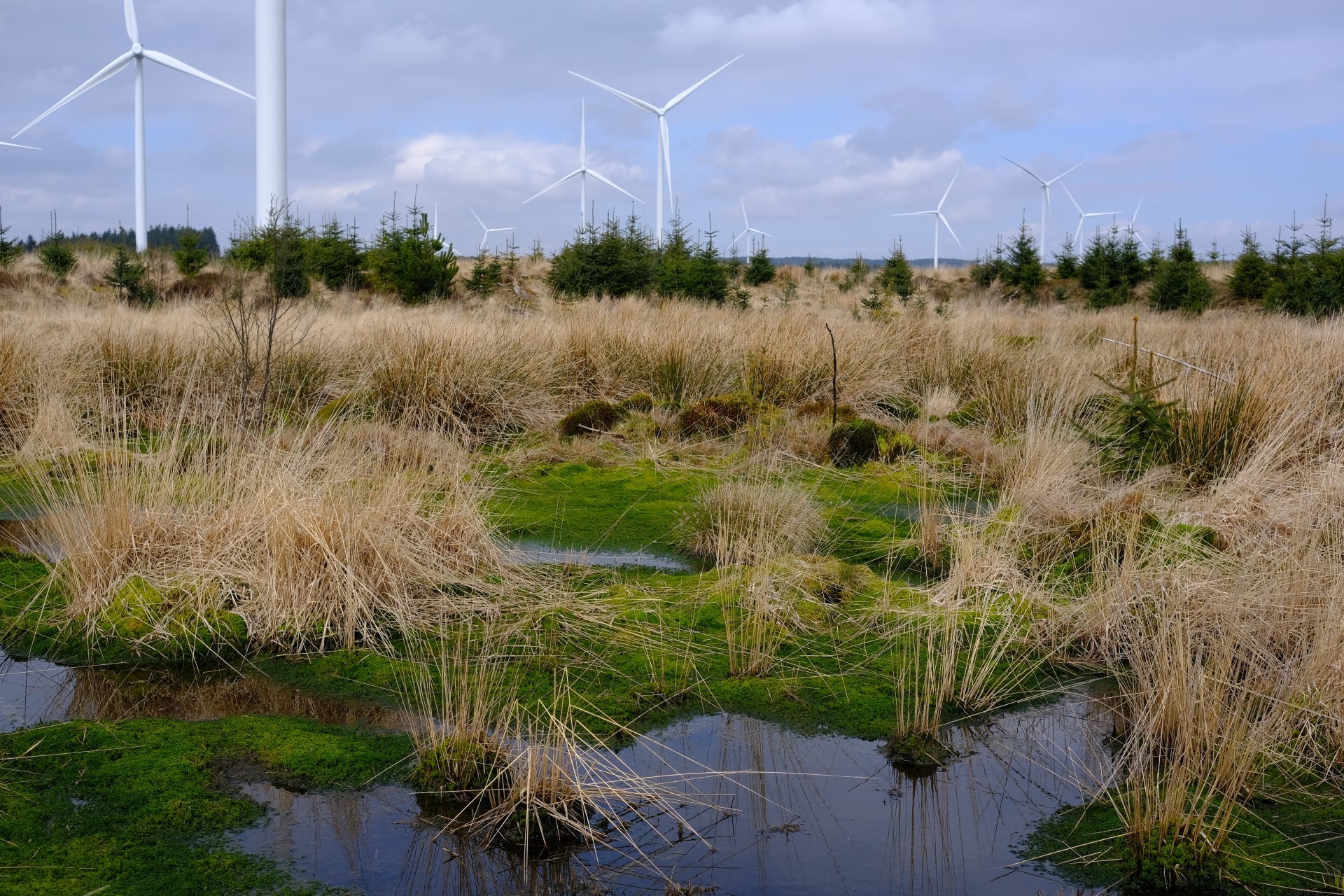When Vattenfall planned the largest onshore wind farm in England and Wales, Pen y Cymoedd, it also took on the restoration of up to around 1,500 hectares of blanket bog and other peatland habitat which had been planted forest.

Restoration is now well underway, bringing back a richness of biodiversity and halting a source of leaking carbon, protecting the remaining carbon stored in the peat deposits, and, with time, returning these peatlands into a carbon sink.
Pen y Cymoedd’s 76 turbines in South Wales can produce enough electricity to power 15 per cent of Welsh homes annually. It also holds a 22 MW battery that can store some of the electricity produced at the site. The wind farm became operational in 2017 and peatland restoration work started two years later.
In around roughly ten years from now, much of the area will start to look like it did before Sitka spruce was planted. In the decades following World War II – before the value of peat as a carbon store was fully understood – this North American fast-growing species of tree was planted on peatland across the United Kingdom for timber production.
Over time however, the importance of peatland for ecosystem services has come to be recognized; apart from its biodiversity and carbon sink benefits, peatlands also provide natural flood management and recreational benefits.
As it was drained to make it dry enough for tree planting, carbon began to escape from the peat. Then as the trees grew, the roots penetrated the peat and caused further drying and cracking that released more carbon.
Reversing the process
Land is now being restored to blanket bog and other types of peatland habitat, reversing the process of carbon leakage. In a healthy peatland ecosystem, the predominant vegetation is moss, in particular sphagnum moss. This moss stores carbon as it is growing, and it also retains significant amounts of water, creating waterlogged conditions that inhibit decomposition, allowing the vegetation to gradually transform into peat. Over time, the peat layer deepens as the vegetation is converted into peat.
“The area stops emitting CO2 and methane and becomes a carbon sink, capturing and storing carbon once again,” says Vattenfall Environmental Specialist Robin Cox.
Restoration work is scheduled outside the breeding season to avoid disturbing birds. The methods are adapted after peat depth and various hydrological factors are categorised. But typically, after the trees have been felled, excavators have to work through a messy-looking landscape of tree stumps in long lines with ditches between them, and with waste branches scattered around. The excavators then flip the stumps upside down, put them back into the peat, and block the drainage ditches.
To avoid dry high points and very wet low points, the excavators are also driving in a specified pattern to flatten and compress the surface. The process helps retain the water on the surface and encourages the return of the sphagnum moss.
Amphibians, reptiles and songbirds
The first vegetation to return however is generally cotton grass, with white fluffy flowers, and the sphagnum moss comes back within around three to five years. Over time, the sphagnum increases its dominance in the landscape. The different sphagnum species can have red, green and ochre colours. Adding to the colour variety is purple from various species of heather.
The earliest areas that were restored in Pen y Cymoedd have fully revegetated and now have sphagnum moss growing on them.
And along with the vegetation come animals
“There will be a significant change in invertebrate communities associated with blanket bog compared to plantation forestry. For example craneflies, black darter, common hawker dragonflies, small pearl-bordered fritillary butterfly, and moths such as Emperor moth and oak eggar. Diversity will definitely increase, attracting species that feed on invertebrates. This will bring in more amphibians, more reptiles, and a greater variety of songbirds. We will see a higher overall diversity across a lot of different species groups,” says Robin Cox.
Among the bird species that can be expected as the blanket bog is restored are skylarks, meadow pipits, stonechats, snipe and possibly curlew, red grouse and ground-nesting raptors such as merlins along with many others.
The endangered rodent, the water vole, is also showing encouraging signs of thriving in the newly restored habitats.
Vattenfall funds research
To ensure the trees don’t grow back, cattle will likely be grazed the area in the future, while further research will be carried out on how to discourage trees from regenerating on restored areas. This will include examining whether felling trees when they are seeding results in more regeneration.
Vattenfall is funding research, on top of the GBP 3 million habitat management plan budget, in cooperation with Swansea University. Various botanical and hydrological perspectives of bog restoration are being researched, as is the carbon balance of restored peatland.
Researchers have set up instruments to measure carbon emissions to determine when during the restoration process the bog shifts from being a carbon source to a carbon sink. By quantifying this, they can estimate how much carbon will be stored over a certain number of years when restoring an area of bog, giving a clearer picture of the true carbon balance of bog restoration efforts.
For both the research and restoration work, Vattenfall’s funding has been leveraged for match funding, including for an adjacent sister restoration project called the Lost Peatlands of South Wales.
The restoration and research in collaborations and partnerships with various stakeholders, including the owner of the land, the Welsh government sponsored body Natural Resources Wales, have led to Pen y Cymoedd becoming a hub for learning and research in the area.
“It is becoming a centre of knowledge and practitioner excellence for this sort of work – restoring bog from forest,” says Robin Cox.

Subscribe to the newsletter THE EDIT
THE EDIT is Vattenfall's new monthly newsletter. Each issue highlights a new burning issue from the world of sustainable energy and fossil freedom.



